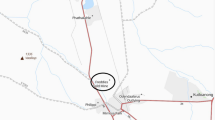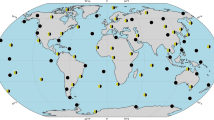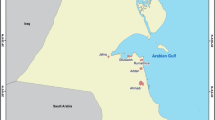Abstract
Trace analysis enables the sensitive detection of radionuclide concentrations in ground-level air in the range of microbecquerel per cubic meter (μBq m−3). Typical sampling intervals of less than one day up to a few days can be used in routine operation. Trace analysis measurements are performed in the framework of the German Integrated Measuring and Information system (IMIS) and the International Monitoring System (IMS) used for verification of the Comprehensive Nuclear-Test-Ban Treaty (CTBT). Within the environmental monitoring programmes of the German IMIS the Federal Office for Radiation Protection (BfS) performs measurements of aerosol-bound radionuclides and of radioactive noble gases in the atmosphere. Aerosols are collected on filters with high-volume air samplers and analysed by γ-spectrometry, α-spectrometry, and integral measurements of β-activity, with preceding radiochemical separation. Noble gas samples from 15 sites world-wide are analysed to observe the 85Kr-release from nuclear fuel reprocessing plants and from seven sites in Germany to monitor the 133Xe emitted from nuclear power plants. As part of the International Monitoring System (IMS) of the CTBT an automatic aerosol sampling and measuring system and an automatic noble gas sampling and measuring system will be operated by the BfS at Mount Schauinsland near Freiburg. Because of its expertise in noble gas measurements the BfS had been chosen to perform an intercomparison experiment in the BfS laboratory in Freiburg with several automatic noble gas sampling and measurement systems before their installation at IMS sites. To establish quality-assurance programmes for trace analysis performed for the German IMIS close collaboration between the involved German institutions has been established. First steps have been taken to expand cooperation to other European laboratories. Informal data exchange already occurs between trace-analysis laboratories in Europe (Ring of Five) and helps in cases of enhanced activity concentrations to get a rapid overview of the radiological situation and to identify possible sources.






Similar content being viewed by others
References
Zähringer M, Bieringer P, Kromer B, Sartorius H, Weiss W (1990) Entwicklung, Erprobung und Einsatz von Schnellmeßmethoden zur nuklidspezifischen Bestimmung atmosphärischer Kontaminationen, IAR-1/90, IAR-Berichte, ISSN 0937–8677, pp 37–29
Weiss W, Sartorius H, Stockburger H (1992) Global distribution of atmospheric85Kr A database for the verification of transport and mixing models. In: Isotopes of noble gases as tracers in environmental studies. IAEA, Vienna, pp 29–62
Stockburger H, Sartorius H, Sittkus A (1977) Z Naturforsch 32:1249–1263
Bowyer SM, Miley HS, Thompson RC, Hubbard CW (1997) IEEE Trans Nucl Sci 44:551
Igarashi Y, Sartorius H, Miyao T, Weiss W, Fushimi K, Aoyama M, Hirose K, Inoue H (2000) J Environ Radioact 48:191–202
WMO/GAW (1995) Report No 109 (TD No 733), Report of an Expert Consultation on85Kr and 222Rn: measurements, effects and applications. WMO/GAW, Freiburg, Germany, 28–31 March
Bowyer TW et al (1997) J Environ Radioact 37:143–253
Kerntechnik, Special Subject: Monitoring the Nuclear-Test-Ban, Vol 66, No 3 (2001)
Bowyer TW et al (1998) Xenon radionuclides, atmospheric monitoring. In: Meyers RA (ed) Encyclopedia of environmental analysis and remediation. Wiley, pp 5299–5314
Bowyer TW, Schlosser C, Abel KH, Auer M, Hayes JC, Heimbigner TR, McIntyre JI, Panisko ME, Reeder PL, Sartorius H, Schulze J, Weiss W (2002) J Environ Radioact, 59:139–151
Acknowledgements
We would like to thank our colleagues of the International Noble Gas Experiment for valuable collaboration during the Noble Gas Equipment Test in Freiburg and for many helpful discussions.
Author information
Authors and Affiliations
Corresponding author
Rights and permissions
About this article
Cite this article
Bieringer, J., Schlosser, C. Monitoring ground-level air for trace analysis: methods and results. Anal Bioanal Chem 379, 234–241 (2004). https://doi.org/10.1007/s00216-004-2499-z
Received:
Revised:
Accepted:
Published:
Issue Date:
DOI: https://doi.org/10.1007/s00216-004-2499-z




